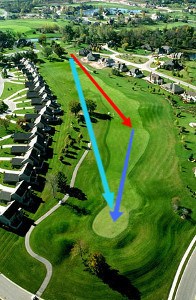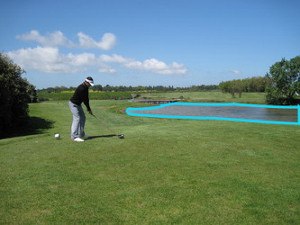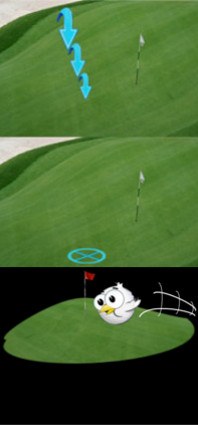
Most dogleg holes feature a hazard of sand, trees or water on the inside corner (i.e. the right corner of a dogleg right, and vice versa). If you automatically aim away from the hazard every time, you're foregoing a chance to capitalize on the hole's strategic design.
The straight line from tee to green is, of course, the shortest route, meaning that a shot directly over a hazard on the inside corner will set you up with a shorter shot to the pin. Playing away from the hazard may seem safer, but it leaves you farther from the ultimate target – and on big-bending doglegs, much farther.
Make a point to check the carry distance over these hazards before teeing off on a hole. If the yardage needed to carry is well within your range, and conditions (i.e. wind) favorable, aim directly at or very close to the hazard.
For example, let's say your average carry distance* with the driver is 220 yards, and you need only 190 to fly past a fairway bunker. That's easily doable with an average shot, and even an off-center hit stands a good chance of covering the needed distance. Trees require flying the ball farther that their actual distance, so always account for their height.
Even if you're not inclined to risk a shot straight over the trouble, taking a line just inside of it will leave a shorter approach than a drive that finishes well wide of the hazard.

What's more, many holes are designed so that the closer you drive to the hazard, the less trouble you'll face on the approach. Drive away from danger and you'll likely face a second shot that must carry sand or stop on the green's narrowest section.
*Make sure you know how far your typical drive flies in the air, not the combined carry-and-roll distance. A launch monitor offers the most dependable means of testing this vital datapoint.
Course management is a tricky topic in the game of golf.

While most of the golf instruction you will find online deals with the swing itself, course management is a skill that should not be overlooked. If you can learn how to make quality decisions throughout each of your rounds, your scores are sure to improve. Many golfers are surprised to find just how many strokes they can cut from their game without actually making any technical changes. Take some time to work on your course management abilities and your game will head in the right direction.
In this article, we are going to talk about one very specific element of course management. This is a situation where you have to deal with a hazard that cuts across the fairway. While standing on the tee, you have two basic choices – lay up short of the hazard or attempt to hit over the hazard and push your ball up closer to the green. Most of the time, course management advice will err on the side of caution, telling you to lay the ball up and play it safe. And, indeed, this is a good option on many occasions. However, from time to time, you will come across a situation where taking the aggressive route is actually the best bet.
It should be mentioned right away that no two situations are exactly the same in golf. Even if you play the same local golf course over and over again, the conditions will constantly be changing, causing you to review your strategy every time you go around the course. For instance, the temperatures for your round may be warm one day and cool the next. That would mean you'd be able to hit the ball farther in that first round, so you might be able to play more aggressively. When the temperatures drop, and your distances shrink, returning to a conservative approach is likely the way to go. Golf is all about being flexible and making each decision based on the situation at hand.
All of the content below is based on a right-handed golfer. If you happen to play left-handed, please take a moment to reverse the directions as necessary.
Assessing the Situation

Each time you step up onto the tee, you are facing a new challenge. Whether you are playing a course for the first time or you have played it several times before, you never know exactly what you are going to find. This is both a good and a bad thing. On the positive side, this kind of variety keeps the game fun over the years. On the downside, it creates more work for you as the golfer. You usually can't just take your driver from the bag and swing away – some amount of forethought needs to be put into crafting a plan that will help you make it safely from tee to green.
The points below should help you assess the situation when you step up onto the tee of a par four or par five hole. Specifically, these tips are designed for use when playing a hole that features a hazard somewhere along the way. This hazard may be right in the middle of the fairway, it may run across the fairway from side to side, or it may guard one side of the fairway. Whatever the case, smart planning is crucial to your success.
- Get the numbers. In golf, everything starts with distance. You need to determine the distance to the hazard, and the distance over the hazard, in order to make any solid decisions. So, for example, picture a hole which has a pond that cuts across the fairway. In this case, the near side of the pond is located 220-yards from the tee. The far side of the pond measures as 250-yards from the tee. So, your options are very clear right away. You'll either need to hit a tee shot that travels less than 220-yards total (including bounce and roll), or you'll need to carry the ball more than 250-yards in the air. As long as you have a reasonable understanding of your distance capabilities, you will know almost immediately if this shot is within your reach. If carrying the ball 250-yards is completely out of the question for you, the layup is the only choice. If you can at least consider hitting the ball that far, you will have to move on to some other considerations.
- Check the conditions. If golf were played indoors, your shots would travel roughly the same distance during each round. Golf is played outside, of course, so that is not the case. The conditions you find on the course will have a dramatic impact on how far the ball flies. Sometimes, the wind will blow, and your distances will be affected either in a positive or negative direction. Or, the temperature will be quite high or quite low, and your distance will change as a result (longer distances in warmer weather, shorter distances on cold days). Needless to say, carrying the 250-yard mark from our previous example would be much harder on a cold day with the wind blowing into your face. Likewise, that mark would be far easier to attain when playing downwind on a warm summer afternoon. You always need to factor the conditions into the equation when evaluating the distance requirements of any shot.
- The surrounding terrain. Determining whether or not you can carry a hazard is only one part of the equation when evaluating the tee shot at hand. You will also need to look at the rest of the hole to make sure it is possible to play this shot aggressively. For instance, if you see that there are plenty of fairway bunkers in play even if you do get over the hazard, the risk may outweigh the reward. On the other hand, if the fairway is wide open once you make it across, playing aggressively will suddenly look a lot more appealing. Don't get so focused on the hazard itself that you forget about everything else that is going to come into play on the shot. A good golfer always sees the big picture, and your decisions should be made based on what that big picture reveals.
- Elevation change. The last quick point we need to make has to do with elevation change. If the shot you are hitting involves a significant amount of uphill or downhill elevation change, you will need to factor that into the math as well. The ball should carry much farther when playing downhill as compared to an uphill shot, all other factors being equal. If you fail to take this into account, you might wind up making a decision that is destined to fail.
As you can see, there is a lot that goes into the decision of whether or not to attempt an aggressive tee shot over a hazard. This is always going to be a personal decision, as only you know what you are capable of doing, and only you can decide if you are comfortable with being aggressive. As you gain experience in these kinds of situations, you'll get better and better at picking the right times to go for it.
The Benefits of a Shorter Approach

There is no doubt that playing an aggressive tee shot over a hazard is going to require taking on some degree of risk. Some situations are riskier than others, but there is at least moderate risk involved anytime you are trying to hit the ball over a hazard. So, in order for that risk to be worth it, there needs to be a worthwhile benefit waiting to be enjoyed. Fortunately, that is the case in many situations. The list below highlights what you may stand to gain when you set yourself up with a shorter approach shot into the green.
- Greater margin for error. When hitting an approach shot from a shorter distance, you will have a greater margin for error with your swing. For instance, a shot that is five degrees off target to the right will not be as far away from the hole when it lands as it would be on a longer shot. So, making a slight mistake from 100-yards will not see you punished in the same way as you would be from 150-yards. By enhancing your margin for error, you will take some of the pressure out of the shot, and you might wind up making a better swing. In the end, you should hit a higher percentage of your greens in regulation when hitting shorter approaches, and you will be likely to set up more makeable birdie putts as well.
- Take bigger numbers out of play. Once you have successfully navigated the tee shot and safely made it to the other side of the hazard, you will have reduced the number of bad outcomes you could experience. By playing from closer to the green, you are unlikely to make a big number on this hole. Sure, you could still make a mistake and wind up with a bogey, but it's unlikely you'll do much worse than that. Obviously, in order to reap this reward, you will have taken on some risk by trying to go over the hazard with your tee shot in the first place. So, the choice comes down to when you would like to take on the risk that is inherent with the hole. Do you want to deal with the hazard off the tee, or will you go over it – and hit a longer approach shot – with your second swing? You may want to make this decision based on the strengths of your game. If you are good with the driver, think about playing aggressive from the tee. Or, if you are an excellent long iron player, the long approach might be the way to go.
- Make birdies! Too often, amateur golfers get caught up with trying to avoid mistakes. In other words, rather than thinking about making birdies – or even pars – many players just think about steering clear of disastrous holes. Your game may benefit if you can manage to turn around this line of thinking. When you play aggressively and take your tee shot over a hazard and close to the green, you will suddenly set yourself up with a reasonable birdie chance. It may require nothing more than a solid wedge shot and a good putt to turn your aggressive tee ball into a birdie. For the average golfer, making just one or two birdies during the course of a round can go a long way toward reaching scoring goals.
It probably goes without saying, but shorter approach shots are almost always easier than longer ones. You are more likely to hit the green when playing from short range, and your chances of making a birdie go way up. With that said, you aren't exactly avoiding risk when setting up a short approach. Instead, you are just shifting the risk away from your approach and onto your tee shot. You will need to come up with a quality swing off the tee if you are going to enjoy the benefits that come with playing short-range approaches.






